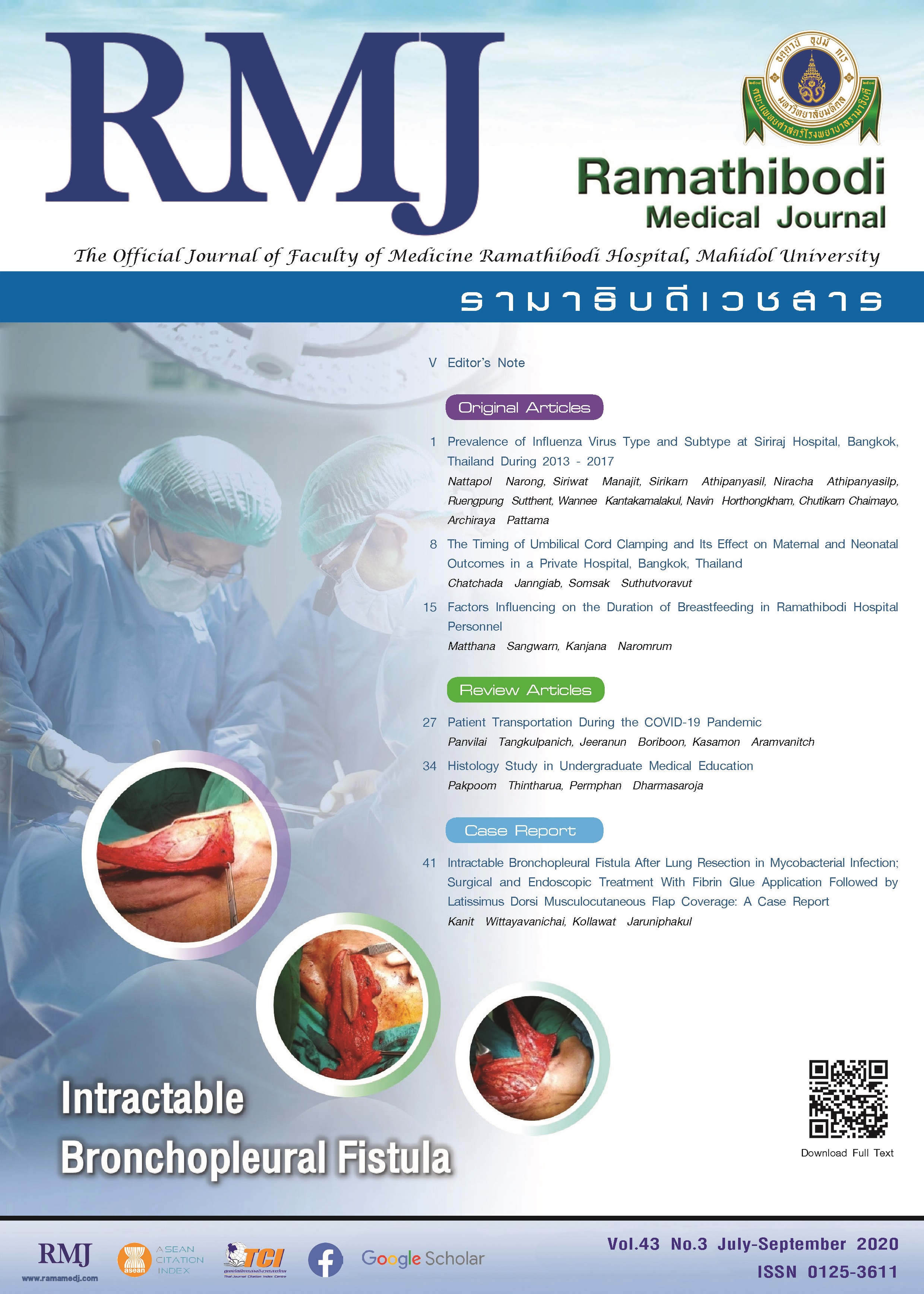The Timing of Umbilical Cord Clamping and Its Effect on Maternal and Neonatal Outcomes in a Private Hospital, Bangkok, Thailand
Main Article Content
Abstract
Background: The timing of umbilical cord clamping after birth is important to neonatal health, and immediate umbilical cord clamping may have negative effects on the newborn’s health. In 2017, the American College of Obstetricians and Gynecologists recommended a delay in umbilical cord clamping in vigorous term and preterm infants for at least 30 to 60 seconds after birth.
Objective: To study the timing of umbilical cord clamping after birth and its effects on mothers and newborns in a private hospital.
Methods: The descriptive prospective observational study was conducted in the labor ward of a private hospital in Bangkok, Thailand. A total of 159 pregnant women were purposively recruited during August 1, 2017, to September 30, 2017. The time after the birth of the umbilical cord clamping was observed and recorded without the knowledge of the obstetricians. Data were analyzed using descriptive statistics.
Results: The mean time of the umbilical cord clamping was 6.20 ± 1.42 seconds (range, 2 - 10 seconds) after the birth which was shorter than the recommendation. No significant association was found between variables and the timing of the umbilical cord clamping. No significant adverse neonatal condition was found.
Conclusions: This study found that time of umbilical cord clamping in a private hospital was shorter than the recommendation and no known side effect to newborns.
Article Details
References
Yao AC, Moinian M, Lind J. Distribution of blood between infant and placenta after birth. Lancet. 1969;2(7626):871-873. doi:10.1016/s0140-6736(69)92328-9.
Linderkamp O. Placental transfusion: determinants and effects. Clin Perinatol. 1982;9(3):559-592.
Rabe H, Diaz-Rossello JL, Duley L, Dowswell T. Effect of timing of umbilical cord clamping and other strategies to influence placental transfusion at preterm birth on maternal and infant outcomes. Cochrane Database Syst Rev. 2012;(8):CD003248. doi:10.1002/14651858.CD003248.pub3.
McDonald SJ, Middleton P, Dowswell T, Morris PS. Effect of timing of umbilical cord clamping of term infants on maternal and neonatal outcomes. Cochrane Database Syst Rev. 2013;(7):CD004074. doi:10.1002/14651858.CD004074.pub3.
Committee on Obstetric Practice, American College of Obstetricians and Gynecologists. Committee Opinion No.543: Timing of umbilical cord clamping after birth. Obstet Gynecol. 2012;120(6):1522-1526. doi:10.1097/01.AOG.0000423817.47165.48.
American College of Nurse-Midwives. Position statement: Delayed Umbilical Cord Clamping. Silver Spring, MD: American College of Nurse-Midwives; 2014. http://www.midwife.org/acnm/files/ACNMLibraryData/UPLOADFILENAME/000000000290/Delayed-Umbilical-Cord-Clamping-May-2014.pdf. Accessed March 1, 2020.
World Health Organization. WHO Recommendations for the Prevention and Treatment of Postpartum Haemorrhage. Geneva: World Health Organization; 2012. https://apps.who.int/iris/bitstream/handle/10665/75411/9789241548502_eng.pdf;jsessionid=E87BFF9ED744FB8FAD004DBC5BD7C33F?sequence=1. Accessed August 7, 2020.
ACOG Committee on Obstetric Practice. ACOG Committee Opinion No. 476: planned home birth. Obstet Gynecol. 2011;117(2 Pt 1):425-428. doi:10.1097/AOG.0b013e31820eee20.
Ibrahim NO, Sukkarieh HH, Bustami RT, Alshammari EA, Alasmari LY, Al-Kadriad HM. Current umbilical cord clamping practices and attitudes of obstetricians and midwives toward delayed cord clamping in Saudi Arabia. Ann Saudi Med. 2017;37(3):216-224. doi:10.5144/0256-4947.2017.216.




